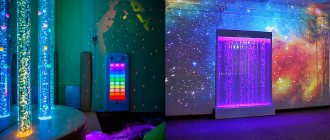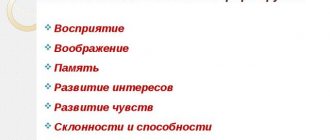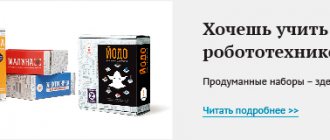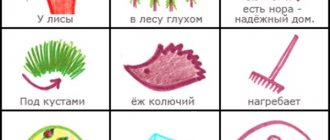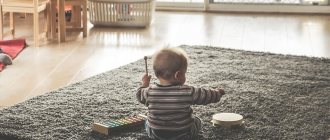Maria Montessori believed that a child's intelligence and knowledge of the world always originate in the senses. Any thought is always preceded by a process of collecting information. This means that the more subtly all the analyzers work, the more chances a person has to solve the problem facing him.
In his book “The Absorbent Mind of the Child,” M. Montessori says that sensory development allows you to open up a whole new world for the baby, making more things and their properties visible, as if someone suddenly turned on the light in a dark room.
It is important to understand that what adults consider obvious, a child has yet to learn: a small stone is lighter than a large stone, but at the same time heavier than a feather, glass is smooth and cold to the touch, and an autumn leaf is warm and rough. A child's absorbent mind is wired for learning, but it is important to place the child in the right environment where he can put his natural curiosity to use.
For more information about Maria Montessori's approach, watch our webinar for parents:
History of Sensory Education in Montessori
Maria Montessori was not the first teacher to draw attention to the importance of developing children's senses. When developing her approach, she relied heavily on the work of the French physician and teacher Edouard Seguin, who at one time worked with children with special needs and created his own system of exercises for developing children’s perceptions and teaching them everyday skills. Jean-Jacques Rousseau and Johann Heinrich Pestalozzi in their works also paid attention to the role of the development of sensory organs in children's learning.
Robert Baden-Powell, founder of the Scout movement and contemporary of Maria Montessori, said that to gain knowledge about the world, children need real experience of interacting with objects. This statement formed the basis of his theory of active learning. He highly valued Maria Montessori's pedagogical approach, noting that if teachers stop commanding and begin to more delicately reinforce a young child's natural need for new experiences, teachers can create a much more solid basis for subsequent learning and development. In his opinion, the idea of education as hard and exhausting work is hopelessly outdated.
Maria Montessori herself began her career working with special needs children who were deprived of adequate sensory stimulation: they had almost no toys, and their whole life was reduced to a series of basic caregiving activities. She was able to clearly prove that changing the living conditions of children significantly changes the level of their abilities. Today, the influence of the environment on a child’s development has been proven at the neurophysiological level. We recommend reading John Medin's book, Rules for Your Child's Brain Development, to become more familiar with this topic.
Maria Montessori created a system of sensory education based on many years of experience observing children and studying the works of outstanding teachers and doctors. Although she was not the first to discover the need for sensory experiences in child development, she was certainly the first educator who was able to draw public attention to this fact.
Time orientation
Tasks:
- show the corresponding time categories in the pictures;
- name the time categories shown in the pictures;
- select a series of pictures to the corresponding time categories and explain the selection criteria.
Age indicators:
4 years : morning, afternoon, evening, night.
5 years : morning, day, evening, night, yesterday, today, tomorrow, seasons.
6 years: morning, afternoon, evening, night, day, earlier, later, yesterday, today, tomorrow, seasons.
Conclusions:
— ideas about time are formed according to age;
— temporary representations are not formed:
— does not find it in the pictures;
- does not name;
- doesn’t explain.
Rules for organizing sensory education according to Montessori
Maria Montessori noticed that at a certain age, children's behavior and motivation are very similar. For example, in the first three years a child is especially sensitive to order. This childish “pedantry” is necessary for the child to create a stable image of this world. It can also be used to develop a child’s natural need for knowledge by creating tasks that are exciting for a certain age, which would help the child master the most important qualities of objects: color, size, shape, material.
As Maria Montessori herself admitted, the work of creating the sets was not easy: it was necessary to create material that would demonstrate properties in isolation, have pedagogical value, and at the same time be attractive to the child. This is how a set of Montessori sensory material appeared.
The main objectives of Montessori sensory exercises
- Teach the baby to perceive, compare and classify sensory experiences of different modalities,
- Expand the child’s sensory experience, teach him to notice even small differences, develop the child’s senses as much as possible,
- Teach your child to use his own memory: “I remember what yellow is, and I can always imagine it in my head,”
- Teach to critically evaluate any information and develop the habit of striving for maximum accuracy when gaining knowledge about the world,
- Create a basis for the emergence of abstract thinking and imagination.
Let us explain with an example how sensory and abstract thinking are connected:
Let's say you've never seen an okapi. Now your task is to imagine this animal by description: it is a bay horse with the legs of a zebra and the head of a giraffe. Happened? If so, congratulations, your sensory development is on point, because for this exercise you need to have an understanding of the colors of horses, the coloring of a zebra and the body structure of a giraffe.
Any abstract idea is essentially a clever interweaving of various information from our real experience. That is why a child’s intelligence begins in early childhood and the ability to exercise all the senses over and over again.
What can you find in the sensory development area of the Montessori center?
Visual information
- Shapes: sets of geometric shapes, as well as more complex shapes (for example, animal figures or plant leaves)
- Volumetric figures: Pink Tower, Brown staircase, Red barbells, Montessori weight cylinders
- Colors: sets of basic colors, card index of shades
Tactile information
- Texture: palpable board, rough tablets, baskets with rags
- Temperature: heat jugs, heat plates
- Weight: weighing cylinders and plates
Stereognostics
- Sorting small items, magic bag
Audio information
- Volume: sound boxes, musical accompaniment of classes
- Height: bells, sound cylinders, musical instruments
Taste and smell
- Taste bottles, conversations during meals
- Jars with scents
In addition to exercises with isolated sensory qualities, in a Montessori space you can always find sets that combine several qualities, such as color and shape:
- Binomial cube
- Trinomial cube
- Constructive triangles
- Montessori squares
- Cylinders without handle
The study of sciences according to M. Montessori also begins with sensory education. Acquaintance with the basic qualities of objects of the natural and cultural world prepares the child for studying social sciences, biology, physics, chemistry and even mathematics:
- Sets of leaves of different plants
- Thematic puzzles
- Maps and globe
- Flags
- Sets with natural materials
- Reproductions of artists and nature photographs
Formation of sensory standards in younger preschoolers through didactic games
The world enters human consciousness only through the door of the external sense organs. If it is closed, then he cannot enter it, cannot enter into communication with it. The world then does not exist for consciousness.
B. Preyerladshikh
Key words: child, sensory development, sensory education, sensory experience, preschool age, standard.
When working with preschool children, the issue of developing a sensory culture is one of the important and priority ones, since sensory development is one of the main aspects of preschool education.
The level of sensory perception and sensory development in general in modern children is somewhat different from the level it was, for example, 10–20 years ago. The reality is that the child has more and more means that allow him to get acquainted with phenomena and objects not in their natural form, but through photographs, drawings, cartoons, computer games, which, of course, does not satisfy the needs for sensory knowledge of objects. At an early age, it is necessary to give the child the opportunity to gain as varied and rewarding sensory experiences as possible.
The problem of sensory education in modern pedagogy has been quite well studied and is in demand. This issue was dealt with by such prominent representatives of preschool pedagogy as J. Komensky, F. Frebel, M. Montessori, O. Decroli, E. I. Tikheyeva and others. A whole system of sensory education was developed by Soviet scientific teachers and psychologists - A. V. Zaporozhets , A. P. Usova, N. P. Sakulina, L. A. Wenger, N. N. Poddyakov.
The word “sensory” comes from the Latin word “sensus” - “feeling”, “sensation”, “perception”, “ability to sense”.
Sensory development is the development in a child of the processes of perception and ideas about objects and phenomena of the surrounding world. Sensory development serves as the basis for knowledge of the world, the first stage of which is sensory experience. Therefore, the main thing at a young age is to enrich the sensory experience necessary for a full perception of the world around us. First of all, it is a replenishment of ideas about the properties of objects: color, shape, size of surrounding objects, position in space. [2, p.10]
The basis of knowledge of the surrounding reality is sensation and perception. The future emergence of such more independent processes as memory, imagination, and thinking depends on the level of their development. In preschool age, the development of sensations and perceptions occurs very intensively. At the same time, correct ideas about objects are more easily formed in the process of their direct perception, both visual, auditory and tactile, in the process of various kinds of actions with these objects. [5, p.4].
Sensory development serves as the basis for the successful implementation of various types of education: mental, aesthetic, physical and even moral, i.e., the development of the child’s personality as a whole. [6 p.3]. The basis of all subsequent mental development, as well as success in school, will depend on how completely a child is cognitively developed. Sensory development is the key to successful mastery of any practical activity, the formation of abilities, and the child’s readiness for school.
For this to take place fully, targeted sensory education is necessary. Sensory education is a targeted pedagogical influence that ensures the formation of sensory experience and the improvement of sensory processes: sensations, perceptions, ideas. [5, p.11]
Preschool age is the period of initial acquaintance with the surrounding reality; At the same time, at this time the child’s cognitive powers and abilities are intensively developing. The child learns about the world, as well as natural phenomena and events in social life that are observable. But knowledge gained through observation and not supported by sensory experience is unclear, indistinct and fragile. Without enriching sensory experience, children often develop superficial ideas. [5, p.12]
Of course, every child, even without targeted upbringing, one way or another perceives the surrounding reality. But if assimilation occurs spontaneously, without the reasonable pedagogical guidance of adults, it often turns out to be incomplete. But sensations and perceptions can be developed and improved, especially during preschool childhood. Therefore, it is important to consistently and systematically include sensory education in all moments of a child’s life, and therefore in the regime moments of a preschool educational institution.
So, one of the main tasks of sensory education of preschoolers is mastering the ability to identify the properties of objects: color, shape, size. These properties should act for children as permanent signs of objects by which objects are recognized and which are important for performing various actions with them. This is the basis for all further work on the development of children's perception.
Starting from the age of three, the main place in the sensory education of children is occupied by familiarization with generally accepted sensory standards and ways of using them. Sensory standards in preschool age are generally accepted examples of each type of properties and relationships of objects developed by humanity. Mastering these skills occurs gradually, starting from a very early age. A common point for all types of sensory standards is that children should first become familiar with the basic patterns, and later with their varieties. When getting acquainted with sensory standards, special attention is also paid to mastering the correct use of the names of the properties of objects.
Sensory standards in the field of color perception are chromatic “color” colors of the spectrum (red, orange, yellow, green, blue, indigo, violet) and achromatic colors - white, gray, black. Full mastery of the system of color standards means familiarity with all color tones, with all shades, with differences in lightness and color saturation, as well as mastering the idea of the sequence of color tones in the spectrum and the possibility of obtaining colors by mixing others. In early preschool age (the fourth year of life), acquaintance with color standards begins with the formation in children of ideas about chromatic colors, white and black colors, and with the assimilation of their names. First, children develop the ability to group objects that differ in shape, size, purpose, but have the same color. Next, the ability to group objects that have the same color, but presented in different shades, is formed. After this, the transition to highlighting and indicating shades is carried out.
Geometric shapes serve as standards of form. At the initial stage of mastering sensory standards, it is necessary to introduce children to only a few geometric figures that reflect in a generalized form the most characteristic forms of real objects. These shapes are square, rectangle, circle, oval, triangle and polygon. The child must be able to separate geometric shapes from other objects, giving them the meaning of samples. This is done by matching each figure with a number of objects of similar shape. Objects (or their images) are grouped around corresponding figures. Then the transition is made to the use of represented samples, to the verbal designation of the shape of objects (round, square, etc.) Finally, the child, having mastered the sensory standards of shape, must be able to analyze objects in the surrounding world that have a more complex shape: first identify the general outlines, shape the main part, the shape and arrangement of smaller secondary parts, and, finally, individual additional parts. At all stages of mastering actions to examine the shape of objects, it is advisable to use the technique of children tracing the outline of an object and its parts. This helps to compare the traced form with the learned standards.
Standards of magnitude are of a special nature, since magnitude is a relative property, and its precise determination occurs using conventional measures. The determination of size, therefore, occurs on the basis of the place that an object occupies in a series of similar homogeneous objects. The standards here are ideas about the relationships in size between objects, denoted by the words “big”, “small”, “largest”. The complication of ideas about the relationships of objects in magnitude consists of a gradual transition from mastering the relationships between two or three objects to mastering the relationships of many objects, forming a series of decreasing or increasing values. For example, by the age of three, a child should be able to select by eye the larger (or smaller) object out of two, then choose an object according to the pattern, when out of two objects you need to choose by eye the one that is equal to the third. The task is even more difficult when you need to use an eye to select two objects by eye, which in their total size are equal to the third (eye “addition”). At the initial stage of acquaintance with magnitude, when it is necessary to move from applying comparable objects to each other to an eye-measuring action, it is advisable to introduce children to the use of the simplest measure. For example, when a child, choosing an object as a sample, measures it with a strip of paper or a cord, and then examines and selects other objects using this measure.
The main means of forming and developing sensory standards in children are: object-based play, didactic games and exercises. This is explained by the fact that in early preschool age the leading type of activity and the basis of a child’s development is play. During the didactic game, you can not only observe the development of certain qualities and skills, but also correct them and direct them in a more correct direction. [3, p. 15]. With the help of didactic games, children develop the ability to think independently and use acquired knowledge in various conditions, in accordance with the assigned game task. It should be noted that games and exercises must be carried out not from time to time, but in a certain system, in close connection with the general course of sensory learning and upbringing of children.
Based on this, in order to form sensory standards and increase the level of sensory development of children, I compiled a system of didactic games. I carry out work on sensory development systematically and consistently, using didactic games and exercises as the main means of sensory education, and including them in various forms of educational work.
Firstly, I drew up a long-term work plan for the development of sensory standards. The distribution of the material was carried out in a sequence that provided for gradual complication from simple to complex. For example, first children become familiar with quite tangible sensory properties - the size and shape of objects that can be examined by touching, and then with color, which is perceived through vision. The sequence is also reflected in the familiarization first with the sharply different properties of objects (round - square shape, red - blue), then with more similar features (round - oval shape, yellow-orange color). In addition, the age of the children and their level of development were taken into account.
The formation of children's ideas about color occurs in stages. At the first stage, children must navigate two contrasting colors and select homogeneous paired objects to match the sample. The following didactic games are suitable for this: “Show the same mosaic”; “Bring the same ball”; “Place it on plates” (you can use new objects each time: felt-tip pens, cubes, caps, so that the children are interested and the proposed game does not get boring); “Find a pair” (mittens, boots). It is important in the first lessons not to name the color of objects (so that children can understand such expressions as “the same” - “not the same”), and also to use the technique of placing one object close to another.
At the second stage, the formation of the ability to navigate in four contrasting colors begins: red, blue, yellow and green. This is facilitated by the selection of various objects (strips, cubes) according to the pattern. At this stage, children enjoy such didactic games as: “Tie the strings to the balls”; “Place a bouquet of flowers in a vase”; “Hide the mouse”; "Sort by color"; "Put a butterfly on a flower." If children make mistakes at first, you can help them using the “model by example” technique. To keep children interested, I use various teaching materials, alternating them throughout the lesson. At this stage, children usually develop an understanding that different objects can have the same color.
The work at the third stage consists of selecting toys, natural materials to match the word indicating the color of the object (4-6 colors). Children complete the following tasks: “Find objects that are only yellow (red, blue, etc.) in color; "The Hen and the Chicks."
To form ideas about the shape of objects, I often encourage children to look for comparisons. For example, I ask the question: “What is the shape of the ball?” I say the phrase: “The ball is round in shape, as round as an orange.” Next, I invite the children to find objects with this characteristic on their own. In this case, it is advisable to carry out such practical actions as superimposing figures, applying, turning over, tracing a contour with your fingers, and palpating. After mastering practical actions, it is easier for the child to recognize the figures that need to be known at a younger age.
To correctly determine the size, children must first develop the ability to select objects of the same size according to a model. Then tasks are selected to develop the ability to distinguish objects by size by applying and superimposing. At the same time, the names of the properties of objects of different sizes are consolidated: “large”, “small”, “short”, “long”, “narrow”, “wide”.
Games for determining magnitude use the largest number of objects prepared in advance. These are toys of different sizes: cubes, balls, boxes. Games such as “Which ball is bigger”, “Big and small dolls”, “Fruit picking”, “Pyramids”, “Find the cube (big or small)” contribute to the development of attention and thinking. Children develop ideas about the size of objects.
To develop tactile sensations, I use games such as “Handkerchief for a Doll”, “Wonderful Bag”, as well as exercises using sensory panels and tactile paths. You can offer children colored sticks, funny laces for dexterous hands, funny clothespins; games with colored plugs and twisting objects, Velcro, brushes: “Decorate the meadow”, “Dress up the Christmas tree”, “Feed the birds”, “Flowers have grown”, “Multi-colored trailers”, etc.
It should be noted that the formation of sensory culture is carried out by me, first of all, in the course of direct educational activities, in routine moments, in joint activities. It is very important to carry out individual work with children who have a low level of sensory development. In my work, I often use the environment to implement sensory education. Great opportunities are provided in the work of familiarizing children with the world around them, especially with nature. For example, during a walk you can organize observation of various objects of living and inanimate nature.
Ultimately, as a result of systematic and systematic work on sensory education of children of primary preschool age, a selected system of didactic games and exercises for preschoolers: 1) the formation and assimilation of a system of sensory standards occurs; 2) the ability to examine objects is formed: to compare, compare, establish patterns between them; 3) mastery of ways to use them in various activities occurs. The system of didactic games for the formation of sensory standards generally increases the level of sensory development and perception in children.
Literature:
- Bashaeva T.V. Development of perception in children. Shape, color, sound. - Yaroslavl: Academy of Development, 1997;
- Wenger L. A. Education of a child’s sensory culture from birth to 6 years” - M.: Prosveshchenie 1995;
- Didactic games and exercises for sensory education of preschoolers. Edited by JI. A. Wenger. M.: “Enlightenment”, 1973.
- Sensory education in kindergarten (Guidelines). Ed. N. P. Sakulina and N. N. Poddyakov. M., “Enlightenment”, 1969.
- Theory and practice of sensory education in kindergarten. Ed. A. P. Usova and N. P. Sakulina. M., “Enlightenment”, 1965
- Pilyugina V. A. Classes on sensory education. - M.: Education, 1983
Montessori Sensory Development Ideas at Home
Despite the fact that Montessori centers use specialized kits for the development of children, it is not difficult to create a game that enriches a child’s sensory experience.
- Animal competitions. Discuss with your child how different animals move and try to organize a competition: draw a start and finish line and ask them to run sideways like a crab, hobble like a bear, or jump like a hare.
- Modeling. Kinetic sand, salt dough, plasticine and clay perfectly develop a child's tactile sensitivity. You don’t have to try to create a masterpiece right away: just learn how to roll balls, flatten them into pancakes, stretch them into sausages, squeeze them and watch how the material seeps through your fingers
- Draw with crayons on the pavement and play hopscotch. Like the previous exercise, this trains not only the senses, but also the child’s coordination.
- Game of silence. Is it just not interesting to remain silent anymore? Invite your child to remember 5 different sounds that he heard during a minute of silence (car horn, bird sounds, people talking, a dropped pencil, etc.)
- Treasure hunt. Draw a list of objects that your child should find during your next walk (a long rough pine cone, a red leaf, a yellow leaf, a dry branch, etc.). Don't forget to take a pen with you to cross out what you find.
- Drawing with stamps, fingers, brushes and even cotton swabs. It is difficult to overestimate the impact of free creative activities on a child’s development.
- Guess the smell. Place items with different scents in opaque boxes: your favorite shampoo, orange peel, a little vanilla, dried cloves, fried cutlet. Organize a competition for the keenest sense of smell.
- Experiment with musical instruments: xylophone, glucophone, kalimba, drum, tambourine, shaker, pipe. It is not necessary to immediately enroll in a music school to introduce your child to music.
- Guess the product by taste. Blindfold your child and ask him to guess what's for lunch today.
- Let your child walk barefoot more often, because there is a whole world under his feet: sand, lawn, stream, pebbles.
Magnitude
Tasks:
- show objects of contrasting size upon request;
- arrange objects in ascending and descending order;
- name the corresponding quantity ratios.
Age indicators:
4 years: long - short, wide - narrow, high - low.
5 years: 4 gradations of each characteristic, determined by comparison (the red stripe is shorter than the yellow one, but wider than the green one).
6 years: 5 gradations of each characteristic, determined by comparison.
Conclusions:
— ideas about size are formed according to age;
- there are no concepts of size:
- does not differentiate objects of contrasting size;
- does not arrange objects in ascending and descending order;
- does not use words in speech that characterize quantities and their relationships.
conclusions
The development of a child begins with the development of his senses. In the 21st century, this is not just the opinion of teachers, but a scientifically proven fact. At an early age, it is very important for a child to learn as much as possible about the world around him using all his senses, which is why no computer can replace a child’s real experience of being in a different environment (forest, park, store, kitchen, etc.). Try to introduce your baby to a variety of objects, and think about how to organize a sensory development area for him, if the ideas of Maria Montessori are close to you.
Results of the study at the ascertaining stage of the experiment
| Total in group | high level | average level | low level | ||||
| quantity | % | quantity | % | quantity | % | ||
| Experimental group | 24 | 5 | 20,8 | 6 | 25 | 13 | 54,2 |
| Control group | 29 | 4 | 13,8 | 11 | 37,9 | 14 | 48,3 |
As the results of the study show, a high level of sensory ideas about color was identified in 4 preschool children in the control group - 13.8% and in 5 preschool children in the experimental group - 20.8%.
The average level of sensory ideas about color was revealed in 11 preschool children in the control group - 37.9% and 6 preschool children in the experimental group - 25%.
A low level of sensory ideas about color was identified in 14 preschool children in the control group - 48.3% and 13 preschool children in the experimental group - 54.2%.
As we can see, the results showed that most children have a low level of formation of sensory ideas about color.
Related posts:
- Experimental study of the development of coherent speech in preschool children with ODD. Diagnosis of coherent speech in children is carried out using accessible...
- From experience in diagnosing and forming creative imagination Research on creative imagination - diagnosis and its formation in children...
- What is "War and Peace" about? Summary of the novel “War and Peace” by chapters. All answers...
- Features of the formation of sensory standards in young children Formation of sensory standards in preschool children. The tasks of forming sensory…
Orientation in space
Tasks:
— show relevant spatial references;
- move in a given direction;
- name the corresponding spatial landmarks.
Age indicators:
4 years: show objects located above, below, in front, behind, left, right.
5 years: show objects located above, below, in front, behind, left, right, in front of me, to my right, to my left.
6 years old: show objects located above, below, in front, behind, left, right, left, between, next to, around.
Conclusions:
— spatial representations correspond to age;
- there are no concepts of space;
- does not perform a movement in the indicated direction according to verbal instructions;
- does not determine position in space in relation to itself;
- does not use words denoting the location of an object in space.


